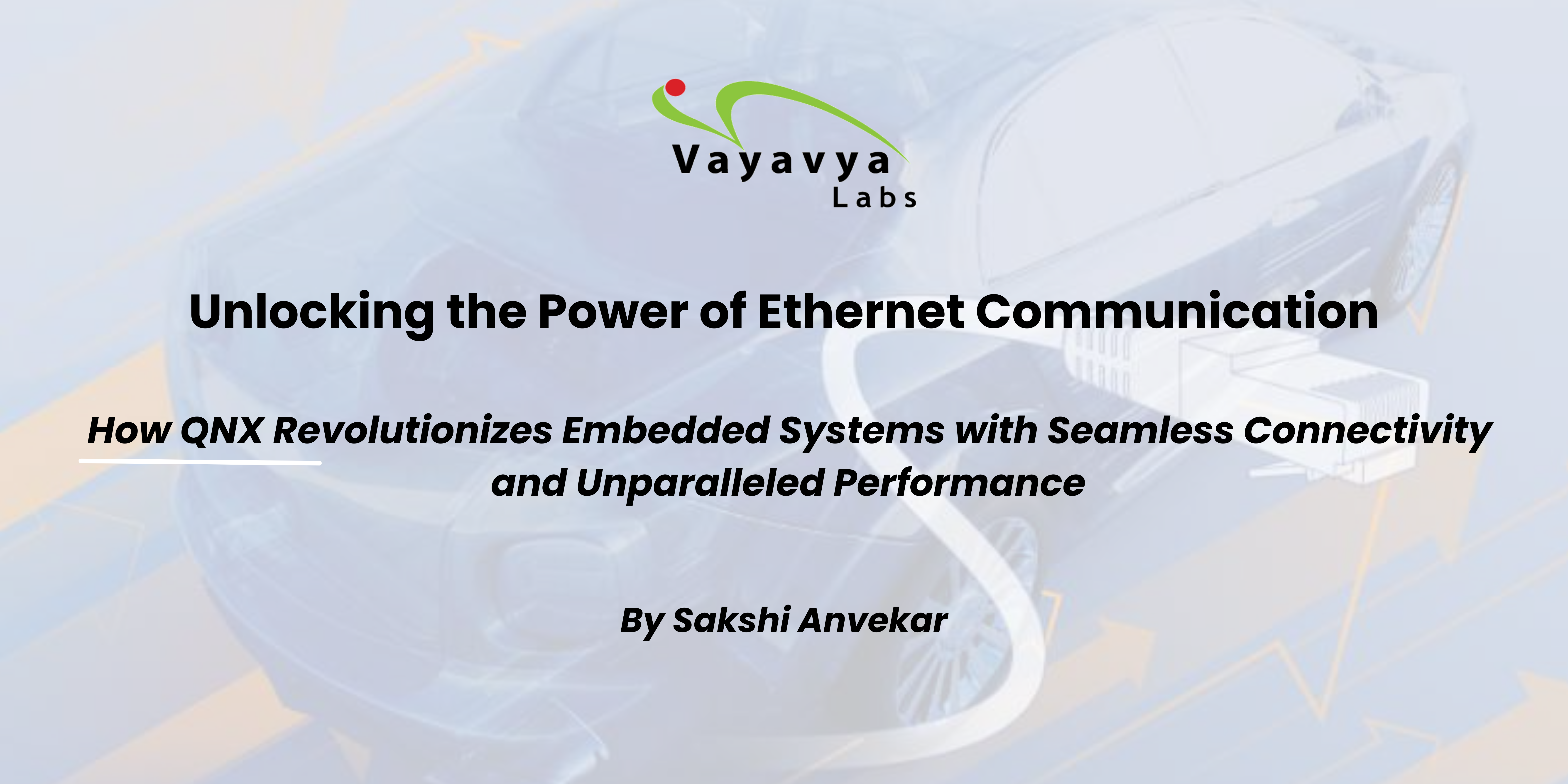Introduction to QNX in Ethernet Communication:
QNX is a commercial Unix-like real-time operating system, aimed primarily at the embedded systems market. QNX was one of the first commercially successful microkernel operating systems.
The core architecture is based on running most of the operating system kernel in the form of a number of small tasks, named Resource Managers. It is a microkernel-based operating system where only essential services like interprocess communication and thread management reside in the kernel space. On the other hand, Linux follows a monolithic kernel approach, where the entire operating system, including device drivers and system services, runs in a single, large kernel.
QNX gained popularity in the vehicle infotainment market due to its customizability and seamless integration with external devices. It is widely used by luxury car manufacturers for their high-end infotainment systems.

It is a real-time operating system (RTOS) designed specifically for embedded systems and has key features like :
- Reliability
- Scalability
- Safety
- Real-time capabilities
- Multi-threading
- Development tools and ecosystem
- Industry adoption
QNX vs. Linux: Similar, yet very different
- QNX is Unix-like, its architecture is fundamentally different: it’s a Microkernel whereas Linux is Monolithic.
- In QNX Microkernel, each software component, including drivers, stacks, OS services, and applications, operates independently as its own process.
Ethernet is essential for communication in embedded systems, enabling reliable connectivity between devices. It facilitates data exchange, control, and monitoring, supporting real-time and high-speed transfers. Ethernet’s standardized protocols simplify development and interoperability, making it crucial for industrial automation, IoT, smart homes, and automotive systems. The versatility and extensive ecosystem of technologies make Ethernet a fundamental component in modern embedded systems

In this blog, we will explore the capabilities of QNX in harnessing the potential of Ethernet communication for embedded systems.
Devices connected to a local area network (LAN) can be connected using Ethernet, which offers a standardized and effective method. Ethernet is frequently used in industrial settings to connect equipment including programmable logic controllers (PLCs), human-machine interfaces (HMIs), sensors, actuators, and other control devices
These embedded devices using QNX can create dependable and quick communication channels by utilizing Ethernet connectivity. Real-time control and monitoring applications benefit greatly from the precision timing and responsiveness that QNX’s microkernel architecture ensures. The embedded devices can manage crucial activities while seamlessly sharing data over the Ethernet network when QNX is used as the underlying operating system.
QNX’s Capabilities in Ethernet Communication:
- Ethernet Stack: QNX offers comprehensive support for various Ethernet protocols.
- QNX provides a robust Ethernet stack that enables efficient network communication. By supporting protocols such as TCP/IP, UDP/IP, ICMP, and ARP. The inclusion of TCP/IP allows for reliable and error-checked data transmission, ensuring the delivery of packets in the correct order. UDP/IP, on the other hand, offers a lightweight and connectionless protocol suitable for applications where real-time performance is critical.
- ICMP (Internet Control Message Protocol): ICMP is a network protocol used for diagnostic and error reporting purposes. QNX’s support for ICMP allows for efficient network troubleshooting, network status monitoring, and error reporting, aiding in the maintenance and management of Ethernet-based systems.
- ARP (Address Resolution Protocol): ARP is a protocol used for resolving the IP address of a device to its corresponding MAC address. It plays a vital role in facilitating communication between devices on an Ethernet network. QNX’s support for ARP ensures efficient address resolution, enabling devices to locate and communicate with each other effectively.
- Network Configuration and Management: QNX offers comprehensive network configuration and management tools that facilitate the setup and adjustment of network parameters in embedded systems. Here are key features and functionalities related to network configuration and management in QNX:
- IP Address Assignment: QNX provides tools to assign IP addresses to devices within the network. Administrators can configure IP addresses manually or dynamically using protocols such as DHCP (Dynamic Host Configuration Protocol). This flexibility enables efficient network addressing and simplifies the process of connecting devices to the Ethernet network.
- Subnetting: QNX supports subnetting, allowing administrators to divide a network into smaller logical subnets. Subnetting aids in efficient network management improves network performance, and enhances security by isolating different parts of the network. With QNX, administrators can define and configure subnets according to the specific requirements of the embedded system.
- Routing Setup: QNX facilitates the setup and management of routing tables, which determine how network traffic is directed between different subnets or networks. Administrators can configure routing rules, specify default gateways, and define routing metrics to optimize network routing and ensure proper connectivity between devices.
- Network Interface Management: QNX provides tools to manage network interfaces, including Ethernet interfaces. Administrators can configure interface properties, such as link speed, duplex mode, and MTU (Maximum Transmission Unit), to ensure optimal network performance. QNX also supports the configuration of advanced features like VLAN (Virtual Local Area Network) tagging for network segmentation and prioritization.
- Device Drivers and Protocol Stacks: QNX, as a leading real-time operating system, provides extensive support for a wide range of Ethernet controllers through its pre-built device drivers. These device drivers are specifically designed to seamlessly integrate with the QNX operating system, offering a reliable and efficient means of connecting and communicating over Ethernet networks in embedded systems. Here are key points regarding QNX’s device driver capabilities for Ethernet communication:
- Flexible Driver Development: QNX offers a flexible platform for developing custom device drivers. This allows developers to create device drivers tailored to specific Ethernet controllers or unique hardware requirements. The flexibility of QNX’s driver development framework enables efficient driver implementation and customization.
- Pre-Built Device Drivers: In addition to custom driver development, QNX provides a comprehensive range of pre-built device drivers for well-known Ethernet controllers. These drivers are readily available, extensively tested, and optimized for compatibility with the QNX operating system. This eliminates the need for developers to create drivers from scratch, saving time and effort in the development process.
- Wide Range of Supported Controllers: QNX supports a broad range of Ethernet controllers from various manufacturers. These include popular chipsets such as Broadcom, Intel, Marvell, Realtek, and many others. The extensive support for different Ethernet controllers ensures compatibility with a wide range of embedded systems and simplifies the integration process.
- Seamless Integration: QNX’s device drivers seamlessly integrate with the operating system, allowing for smooth communication between the embedded system and the Ethernet controller. This integration ensures reliable and efficient data transfer over Ethernet networks, meeting the demands of real-time and high-performance applications.
- Robust Testing and Optimization: QNX’s device drivers undergo rigorous testing and optimization to ensure their reliability, stability, and performance. This rigorous testing process guarantees that the drivers meet industry standards and deliver optimal performance in demanding embedded systems.
- Security and Encryption: QNX recognizes the critical importance of network security in Ethernet communication and offers robust security and encryption features. Here’s an elaboration on the security capabilities provided by QNX:
- Encryption with AES: QNX incorporates AES (Advanced Encryption Standard), which is a widely accepted and trusted encryption algorithm. AES ensures that sensitive data transmitted over Ethernet networks is encrypted, providing a strong layer of security against unauthorized access. By using AES, QNX safeguards the confidentiality of data, preventing it from being intercepted or deciphered by unauthorized parties.
- IPsec Compatibility: QNX supports IPsec (Internet Protocol Security), a widely used security protocol in corporate networks. IPsec provides secure and encrypted communication across Ethernet networks by establishing a secure tunnel between devices. It offers authentication, data integrity, and confidentiality to ensure that data transmitted over the network remains secure and protected from eavesdropping and tampering.
In conclusion, leveraging QNX’s capabilities in Ethernet communication for embedded systems provides a transformative solution for seamless and efficient connectivity. QNX’s robust features, including reliability, scalability, safety, real-time capabilities, multi-threading support, development tools, and industry adoption, make it a standout choice. With QNX, embedded systems can achieve reliable and secure Ethernet communication, ensuring uninterrupted data transfer, precise timing, and optimal performance. The availability of pre-built device drivers, compatibility with popular Ethernet controllers, and strong security measures further enhance its appeal. By harnessing QNX’s capabilities, developers can unlock the true potential of Ethernet communication, enabling innovative and connected embedded applications across diverse industries.
Connect with us to know more about what we are doing in the space of Automotive Ethernet.
Alternatively, you can also write to us at sales@vayavyalabs.com

